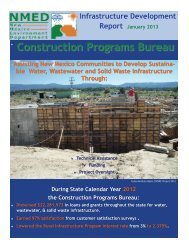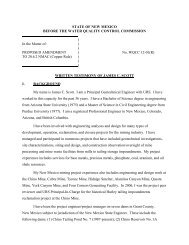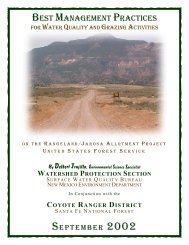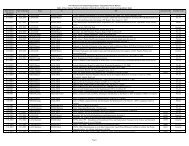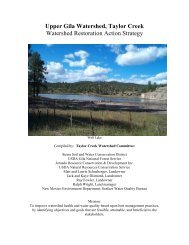Surface and Precipitation Stations - New Mexico Environment ...
Surface and Precipitation Stations - New Mexico Environment ...
Surface and Precipitation Stations - New Mexico Environment ...
Create successful ePaper yourself
Turn your PDF publications into a flip-book with our unique Google optimized e-Paper software.
4.3 Downwash<br />
Because the modeling conducted for BART is concerned with long-range transport, not localized<br />
impacts, data regarding building heights <strong>and</strong> widths that are used to calculate building downwash<br />
will not be included in the modeling analyses. Stack tip downwash is a phenomenon different from<br />
building induced downwash <strong>and</strong> is additionally a regulatory default option (i.e., in order to turn stack<br />
tip downwash off, the user must also change the variable to skip regulatory checks of the model). As<br />
such, this PNM Protocol proposes that stack tip downwash remain “on” for this analysis as<br />
recommended by the WRAP Protocol.<br />
4.4 Ozone Concentrations<br />
Background ozone concentrations are important for the photochemical conversion of SO2 <strong>and</strong> NOx<br />
to sulfates (SO4) <strong>and</strong> nitrates (NO3), respectively. CALPUFF allows the use of a single background<br />
ozone value, monthly background ozone values, or spatial, hourly ozone data from one or more<br />
ozone monitoring stations (the preferred method) to represent the background ozone concentrations<br />
within the domain.<br />
The hourly ozone concentrations files that were used by WRAP RMC in the initial modeling will be<br />
used for the BART technology evaluation. These hourly ozone data files will be obtained directly<br />
from the WRAP RMC website. In addition to the hourly ozone data, the same monthly average<br />
background ozone value of 80 ppb as used in the initial modeling will be used in this modeling for<br />
times when hourly ozone data are not available.<br />
4.5 POSTUTIL <strong>and</strong> CALPOST<br />
The two main postprocessors of interest for BART applications are the POSTUTIL <strong>and</strong> CALPOST<br />
programs. The POSTUTIL processor is a program that has several functions, including creating<br />
cumulative impacts of multiple sources from different simulations via summation, computing the<br />
difference between two sets of predicted impacts (useful for evaluating the benefits of BART<br />
controls), <strong>and</strong> evaluating the equilibrium relationship between nitric acid <strong>and</strong> nitrate aerosols via a<br />
chemistry module. The later function allows the potential non-linear effects of ammonia scavenging<br />
by sulfate <strong>and</strong> nitrate sources to be evaluated in the formation of nitrate from an individual source.<br />
As previously mentioned, the POSTUTIL postprocessor will be used to create the speciated<br />
components of PM10 based on the size distribution of the NPS speciation spreadsheet. The new<br />
concentration file created by POSTUTIL will then be used as input for the CALPOST postprocessor.<br />
CALPOST is used to process the CALPUFF outputs by producing tabulations summarizing the<br />
results of the simulations, identifying, for example, the highest <strong>and</strong> second-highest hourly-average<br />
concentrations at each receptor. When performing visibility-related modeling, CALPOST uses<br />
concentrations from CALPUFF (or POSTUTIL) to compute light extinction <strong>and</strong> related measures of<br />
visibility (haze index in deciviews), reporting these for a 24-hour averaging time. The selections of<br />
the specific variables used in POSTUTIL <strong>and</strong> CALPOST are provided in Appendices E <strong>and</strong> F,<br />
respectively.<br />
4-3 4/13/2007



